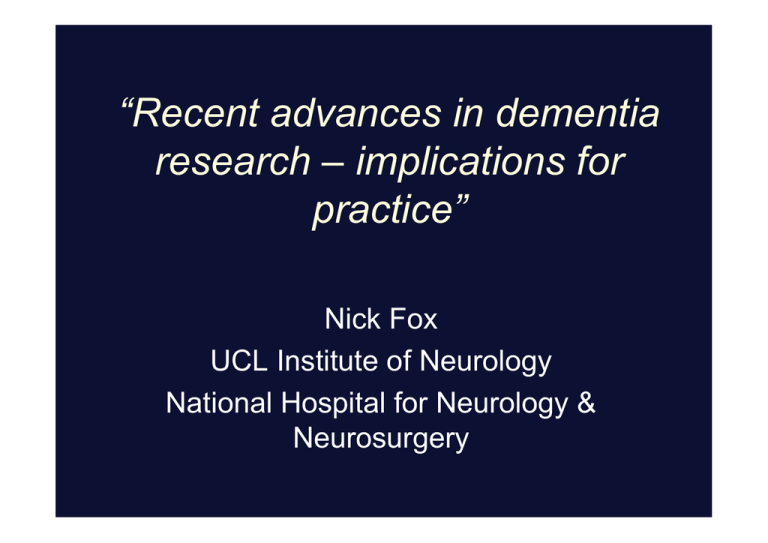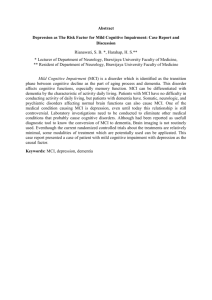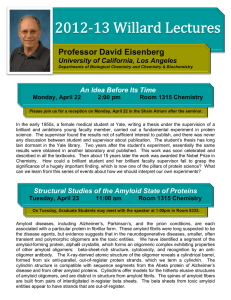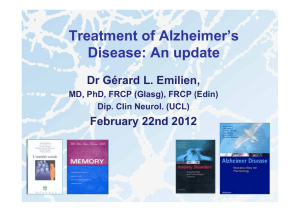Recent advances in dementia research – implications for
advertisement

“Recent advances in dementia research – implications for practice” Nick Fox UCL Institute of Neurology National Hospital for Neurology & Neurosurgery The dementia research landscape: a time of change • Public awareness • Priority for governments • Importance of diagnosis: … of diseases and dementia • Translating advances to practice is a major challenge • Great opportunities for UCLP Research into Cause, Cure and Care Advances in many dementias: FTD, DLB & AD… 1. The new genetics: GWAS 2. The new culprits? Amyloid cascade & oligomers 3. New diagnostic markers: CSF & amyloid imaging 4. New diagnostic criteria 5. Treatment promises, failures and concerns Alzheimer’s disease genetics AD and the “new genetics” • 1920/30s – inherited forms of AD recognised • 1991 – First pathogenic mutation in APP (the London mutation - 717) • 1993 – ApoE4 (Chr19) risk factor reported • 1995 – Presenilin1 (Chr14) and PS2 (Chr1) • 2009 – Genome wide association studies (GWAS) Genetic risk factors and sporadic AD • ApoE4 – strongest genetic risk factor • ~3x with one allele; ~9x with two • Genome Wide Association Studies (2009) • CLU (Clusterin) • PICALM • CR1 • BIN1 • Involved in cholesterol metabolism, complement cascade ... offers new targets The new culprits in the amyloid cascade? APPsβ APP processing, Aβ aggregation, and amyloid pathology Aβ Aβ β γ AICD Aβ Aβ Protofibrils/Fibrils Amyloid Plaques Haass, Schlossmacher et al, Nature The new era of biomarkers in Alzheimer’s disease: MRI, CSF (and PET) At diagnosis of AD the hippocampus is 10-20% smaller than in controls Rates of h/c atrophy ~3-4%/y; controls <1%/y Baseline 18 months 36 months Serial coronal MRI of initially mild FAD MCI Scan 1 MCI - AD Scan 2 MCI Scan 1 MCI - AD Scan 2 CSF in AD – proving very useful • Aß1-42 reduced (x ~0.5 vs Controls) • Tau increased (x ~2 vs Controls) Tau/Aß ratio increased >1 suggests AD Good sensitivity and specificity vs controls (tau also up in CJD, FTD) NB - use polypropylene tubes and get the samples to the lab! CSF Aβ reduction and tau elevation ~85% sensitive, 85% specific for AD (even at MCI stage) Hansson et al. Lancet Neurology 2006 Amyloid Imaging in AD Klunk 2004 – PIB (C11); now multiple ligands (F18) Amyloid binding increases some years before AD MCI “Converted” to AD MCI No change in 4 yrs Brooks, Archer, Fox et al., New criteria for AD Earlier diagnosis? Earlier Treatment? Improving diagnosis • National priority – “Dementia Strategy” • Alzheimer’s Society “…it is crucial to highlight the value of early diagnosis and intervention…” • New criteria – Dubois et al 2007 – NIA-AA 2011 Disease modification in AD: beyond cholinesterase inhibitors Some failures, some concern, some promise • Symptomatic treatments (now with wider NICE guidance) have modest benefit • Increasing concern about neuroleptic use • Search for disease modification – need to recruit into trials – Anti-tau therapies – Gamma-secretase inhibitors – Amyloid Immunotherapy – And others Amyloid Plaques in transgenic mice prevented by immunisation Hippocampus Hippocampus Placebo (PBS) treated Aß42 treated Immunotherapy - vaccination in humans Active study – AN1792 ~300:72 subjects 15 months – series of vaccinations Clinical, safety, cognitive & MRI measures XX32aa XX32da BBSI 20mL Autopsy evidence of extensive patchy removal of plaques Unimmunised AD Immunised Nicoll et al Neuropathology of AD after immunization with amyloid- peptide. Nat Med 2003;9:448-52 Holmes et al Long terms effects… Lancet 2008 Several ongoing immunotherapy trials in AD Rinne J Lancet Neurology 2010 Salloway S et al Neurology 2009 Bapi phase 2 completed – phase 3 by 2012-3 Summary • Some progress in understanding the cause(s) of AD • New markers and criteria will influence practice • Need to find disease modification therapies – may need to trial earlier in the disease Thank you





